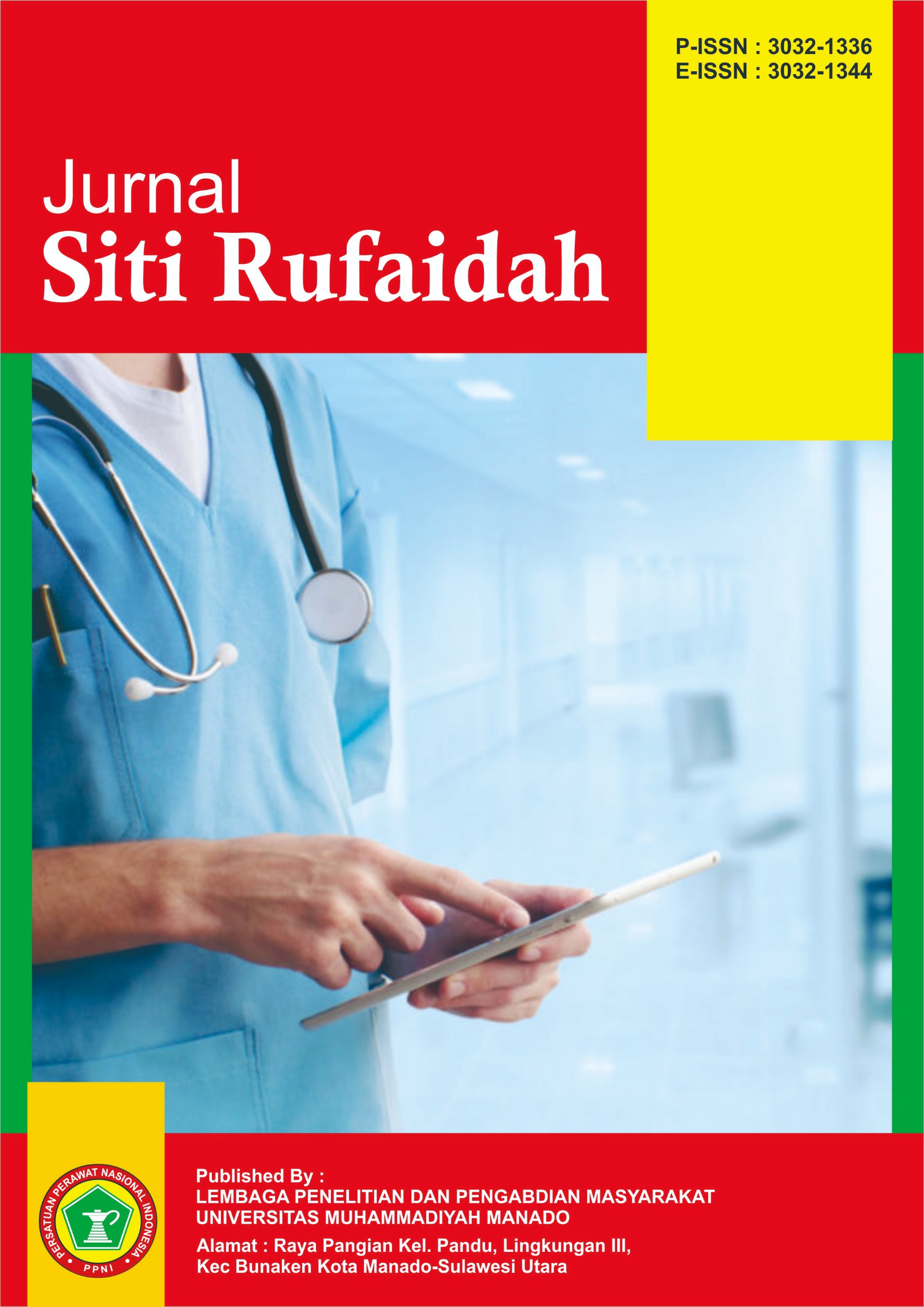Hubungan Kecemasan dengan Kadar Nilai Glukosa Darah Pasien Diabetes Melitus di RSUD Fakfak
DOI:
https://doi.org/10.57214/jasira.v3i3.230Keywords:
Anxiety, Blood glucose, Diabetes mellitus, Hospital care, Psychological conditionAbstract
Diabetes mellitus is a chronic metabolic disease that affects not only the physical condition but also the psychological aspect of patients, particularly anxiety. This psychological condition can influence blood glucose stability and potentially worsen the clinical state of patients. The aim of this study was to analyze the relationship between anxiety and blood glucose levels among patients with diabetes mellitus at Fakfak General Hospital. The study applied a quantitative approach using an observational analytic method with a cross-sectional design. The sample consisted of 50 patients selected through total sampling. Anxiety data were collected using a questionnaire, while blood glucose levels were obtained from laboratory results. Data were analyzed using univariate and bivariate methods with the Chi-Square test at a significance level of p < 0.05. The findings showed that most patients experienced anxiety (96%) and the majority had normal blood glucose levels (70%). The Chi-Square test revealed a p-value of 0.000, indicating a significant relationship between anxiety and blood glucose levels in patients with diabetes mellitus at Fakfak General Hospital. This study highlights the importance of addressing psychological conditions as part of a comprehensive diabetes management program. It is recommended that health care services provide special attention to anxiety management as an effort to improve the quality of life of diabetic patients.
References
Adiputra, I. (2021). Metode penelitian kesehatan. Yayasan Kita Menulis.
Aisyah, M. (2023). Gambaran kecemasan pasien diabetes mellitus tipe 2 dalam berbagai tingkat neuropati di wilayah kerja Puskesmas Kassi-Kassi Kota Makassar (Skripsi). Universitas Hasanuddin.
Alfaqih, M. R., HS, A. A., & Khayudin, B. A. (2022). Manajemen penatalaksanaan diabetes mellitus. GUEPEDIA.
Ambarwati, L. C., Tomasoa, J., Iwan, & Nopriyanto, N. D. (2024). Diabetes mellitus tipe 2: Konsep penyakit dan tatalaksana. Penerbit Qiara Media.
Antar, S. A., Ashour, N. A., Sharaky, M., Khattab, M., Ashour, N. A., Zaid, R. T., & Roh, E. J. (2023). Diabetes mellitus: Classification, mediators, and complications; a gate to identify potential targets for the development of new effective treatments. Biomedicine & Pharmacotherapy, 168, 115734. https://doi.org/10.1016/j.biopha.2023.115734
APA. (2020). Anxiety. American Psychological Association. https://www.apa.org/topics/anxiety#:~:text=Anxiety%20is%20an%20emotion%20characterized,the%20APA%20Dictionary%20of%20Psychology
Ariskawati, H., Bahtiar, H., & Yusuf, H. M. (2017). Pengaruh kecemasan terhadap kadar glukosa darah pada penderita diabetes melitus di RSUD Syekh Yusuf Gowa. Politeknik Kesehatan Makassar, 08(02), 2087–2122.
Astuti, A., Sari, L. A., & Merdekawati, D. (2022). Perilaku DIIT pada diabetes mellitus tipe 2. Zahir Publishing.
Banday, M. Z., Sameer, A. S., & Nissar, S. (2020). Pathophysiology of diabetes: An overview. Avicenna Journal of Medicine, 10(04), 174–188. https://doi.org/10.4103/ajm.ajm_53_20
Centers for Disease Control and Prevention. (2024). Diabetes and mental health. https://www.cdc.gov/diabetes/living-with/mental-health.html
DeFronzo, R. A. (2004). Pathogenesis of type 2 diabetes mellitus. Medical Clinics of North America, 88(4), 787–835. https://doi.org/10.1016/j.mcna.2004.04.013
Dinas Kabupaten Fakfak. (2019). Profil kesehatan Kabupaten Fakfak 2019 (pp. 1–35).
Elsayed, N. A., Aleppo, G., Aroda, V. R., Bannuru, R. R., Brown, F. M., Bruemmer, D., Collins, B. S., et al. (2023). Classification and diagnosis of diabetes: Standards of care in diabetes—2023. Diabetes Care, 46(Suppl. 1), S19–S40. https://doi.org/10.2337/dc23-S002
Ewald, N. (2013). Diabetes mellitus secondary to pancreatic diseases (type 3c)—Are we neglecting an important disease? European Journal of Internal Medicine, 24(3), 203–206. https://doi.org/10.1016/j.ejim.2012.12.017
Fitri, A., Jafar, N., Indriasari, R., Syam, A., & Salam, A. (2021). Hubungan tingkat stress dengan kadar glukosa darah pada polisi yang mengalami gizi lebih di Polresta Sidenreng Rappang. JGMI: The Journal of Indonesian Community Nutrition, 10(1), 25–33. https://journal.unhas.ac.id/index.php/mgmi/article/view/20353
Ghaida, V. H. (2024). Mengenal komplikasi diabetes melitus. https://yankes.kemkes.go.id/view_artikel/3230/mengenal-komplikasi-diabetes-melitus
Guyton, A. C., & Hall, J. E. (2016). Textbook of medical physiology (13th ed.). Elsevier.
International Diabetes Federation. (2021). Diabetes in Indonesia (2021). https://idf.org/our-network/regions-and-members/western-pacific/members/indonesia
Isnaini, N., & Ratnasari, R. (2018). Faktor risiko mempengaruhi kejadian diabetes mellitus tipe dua. Jurnal Kebidanan dan Keperawatan Aisyiyah, 14(1), 59–68. https://doi.org/10.31101/jkk.550
Januardi. (2024). Dinkes Fakfak perkuat edukasi penyakit diabetes melitus. https://www.rri.co.id/kesehatan/1185973/dinkes-fakfak-perkuat-edukasi-penyakit-diabetes-melitus
Luthfianto, D., Noviyanti, R. D., & Kurniawati, I. (2019). Mengontrol glukosa darah dengan bekatul. AE Media Grafika.
Made, I. A. (2021). PB Perkeni pedoman pemantauan darah mandiri. https://pbperkeni.or.id/wp-content/uploads/2021/11/22-10-21-Website-Pedoman-Pemantauan--Darah-Mandiri-Ebook.pdf
Marwaha, S. P. C., & Raman. (2023). Anxiety. National Library of Medicine. https://www.ncbi.nlm.nih.gov/books/NBK470361/
Nursalam. (2020). Metodologi penelitian ilmu keperawatan (P. P. Lestari, Ed.; 5th ed.). Salemba Medika.
Sugiyono. (2020). Metode penelitian kuantitatif, kualitatif, dan R&D. Alfabeta.
World Health Organization. (2024). Diabetes. https://www.who.int/health-topics/diabetes#tab=overview
Downloads
Published
How to Cite
Issue
Section
License
Copyright (c) 2025 Jurnal Siti Rufaidah

This work is licensed under a Creative Commons Attribution-ShareAlike 4.0 International License.






